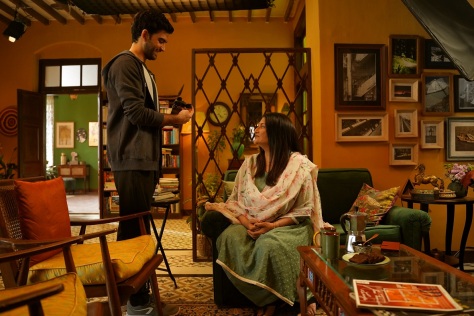
Netflix‘s Dahmer is a psychological crime drama based on the true story of the serial killer, Jeffrey Dahmer. Dahmer is a limited series of ten episodes that focuses on his crimes, his motives, his victims, and the impact on American society and community, both white and black.
I will say that Dahmer is truly a courageous project pulled by Netflix as the creators Ryan Murphy and Ian Brennan along with the team of writers and directors brought the best outcome of the entire showcasing of the bloody psycho show.
The two words to praise the show’s content and intent will be; disgusting and disturbing. Do I need to explain why I used these two words? I don’t think so. But I must admit that at the halfway mark, I really felt that Dahmer being immensely horrible was tested to limits.

And full marks to Evan Peters who pulled a performance to make you hate him and curse him, I mean Dahmer. The reason I am clarifying this is because on the TV Time app, I observed to my surprise that many voters were criticizing other voters to vote for Evan Peters. Whereas the vote was for the actor, of course not for Dahmer. People really must not be that foolish I swear.
Now the objective of this show was successfully achieved from all aspects. Dahmer’s origins, his childhood, his bullying in school, the parents fighting, the birth of killing instincts, the sexual disorder, the obsession with killing, the show covered everything. And that is the beauty of television that is difficult to achieve in a motion picture.

Dahmer’s parents are worth observation. Dahmer’s mental disturbance was the result of his parent’s fights and divorce. His father was more at fault for exposing him to dead animals on the streets. After Dahmer was arrested, the father realized way too late and he confessed to him in court that he got the same feelings as him. So this torch of madness passed from father to son.
There is a generous need of distinguishing the podium of the significance of the central character. Because the makers here didn’t glorify the serial killer. More than Dahmer being a Milwaukee Cannibal, the show focused on the mental areas of disturbance that caused Dahmer to hurt people.

After Dahmer’s sentencing, the show had two more episodes and perhaps the audience at that point begins to think why further. The reason is that ‘impact’. The writers and makers wanted to show the impact his trial made in America. And it was no joke. The system was rightfully questioned. The law and order, the police, and safety issues were put into question. When Dahmer was committing those brutal crimes, no cop was interested to check him. To my utter surprise, he escaped from getting caught every time before his arrest.
And this is where the sociopolitical agenda strikes the right chords; the injustice with the African-Americans! Superbly dramatizes the double standards of how the Black community was heavily ignored when they complained. Police escorting the 14-year-old kid back to Dahmer’s residence was just insane. The episodes on Tony, Glenda, and Dahmer’s parents were necessary fills.

The ninth and the second-last episode breaks the audience with zero optimism for four reasons. The cops getting awards? Arresting Sandra for breaking a camera? The cops making threatening calls to the victim’s family! And Jeff establishing fanhood!
The world is so sick that people can get inspiration from his killings, become his fans, send him letters, and request his autograph. How will psychopaths like Dahmer not be encouraged? White supremacy is another tragic angle. Three young white boys taking pictures in front of that building with a killing pose? This is the precise problem that needs to be addressed. No wonder how many Dahmers are there in America and other countries.

Dahmer shows honesty in historical accuracy and distances from sensationalizing. From the technical aspects of filmmaking, the direction is impressive, especially the episodes directed by Jennifer Lynch. The music score of Nick Cave and Warren Ellis is gloomy. Besides Evan Peters’ unforgettably sublime performance, Niecy Nash as Glenda and Richard Jenkins as Dahmer’s father were excellent. The latter’s emotional breakdowns were accurate.
Dahmer makes the audience cold like dead meat smoldering with complaints that no one will listen to. It is a sad case that makes you sick and humiliated that there are people like Dahmer who are just one step away to finish you in the worst possible way and destroy your family.
RATINGS = 8.6/10
SUBSCRIBE TO MY YOUTUBE CHANNEL AND WATCH MY VIDEO FILM REVIEW HERE
FOLLOW ‘THE DARK KNAIK’ ON OTHER SOCIAL PLATFORMS
TIKTOK https://www.tiktok.com/@thedarkknaik
FACEBOOK https://www.facebook.com/thedarkknaik
INSTAGRAM https://www.instagram.com/thedarkknaik/






















































